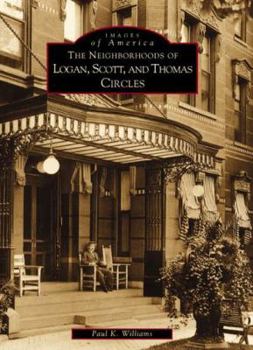The Neighborhoods of Logan, Scott and Thomas Circles
(Part of the Images of America: D.C. Series)
Select Format
Select Condition 
Book Overview
Visit the important developments in these Washington DC neighborhoods, the stately homes and notable citizens in this compelling visual record. From the farm and orchard lands of the mid-1880s to the Civil War encampments, from modest wood frame homes to vast residences of Victorian splendor, the area surrounding the closely located Logan, Scott, and Thomas Circles has for many years been at the center of a rich history. Comprising...
Format:Paperback
Language:English
ISBN:0738514047
ISBN13:9780738514048
Release Date:November 2001
Publisher:Arcadia Publishing (SC)
Length:128 Pages
Weight:0.65 lbs.
Dimensions:0.3" x 6.7" x 9.3"
Customer Reviews
2 ratings
Three Circles in Washington D.C.
Published by Thriftbooks.com User , 16 years ago
Within a few blocks of each other in Washington, D.C. lie three circles with equestrian statues commemorating three American heroes. Logan Circle, located at the intersection of 13th street and Rhode Island and Vermont Avenues N.W. and Massachusetts Ave N.W. honors General John Logan, a hero of the Battles of Vicksburg and Atlanta, a founder of Memorial Day, and a U.S. Senator and unsuccessful vice-presidential candidate in 1884. Thomas Circle, located about two blocks west of Logan Circle at 14th and Massachusetts Ave N.W. honors Civil War General George Thomas, one of the Union's greatest generals best-known as the "Rock of Chickamauga". Two blocks further west at 16th and M Street is Scott Circle, named for Winfield Scott, a hero of the War of 1812, the Mexican-American War, several Indian wars, and the Civil War, and unsuccessful presidential candidate in 1852. Each of the three circles has a long history and each has witnessed much of the varied life of the city. In his book "The Neighborhoods of Logan, Scott, and Thomas Circles", (2001), Washington D.C. architectural historian Paul K. Williams offers a photographic history of each of the three circles. This book is part of the "Images of America" series of Arcadia Press which celebrates in photographs much of the local history of the United States. Williams has written several books on Washington D.C. neighborhoods for Arcadia Press, including a volume on Dupont Circle, which lies only a few blocks west of Scott Circle. In his book, Williams presents a brief introduction to Logan, Thomas, and Scott Circles, followed by separate chapters devoted to each neighborhood. Today's Logan Circle began its history as a Civil War camp which became notorious as a site for hanging deserters and spies. After the Civil War, the Circle became a premier Washington, D.C. residential area, the home of notables such as Ulysses Grant and John Logan himself. At the turn of the Century Logan Circle became home to Washington D.C.'s black elite. The statute to Logan was dedicated in 1901, and Congress changed the name of the circle from "Iowa Circle" to Logan Circle in 1930. Beginning in 1940s, Logan Circle entered into a long, severe period of decline and blight. Together with Thomas Circle, Logan Circle became the center of Washington D.C.'s red-light district, downplayed somewhat by Williams. Rehabilitation of the area began in earnest in the 1970s and continues today. The area was recognized as a Historic District in 1972. Williams offers fascinating views of the many historic homes in the Logan Circle area and of persons who have called Logan Circle home, including early Civil Rights leader Mary McLeod Bethune, and Bishop Charles "Sweet Daddy" Grace, the founder of the D.C. church known as the "United House of Prayer for all People." The most impressive photographs are those of Logan Circle itself, at various times, seasons of the year, and states of repair. The Circle and General Logan bear witness
Great neighborhood resource
Published by Thriftbooks.com User , 22 years ago
Williams is doing a marvelous job of illuminating the history of Washington DC's neighborhoods (first title was the Dupont Circle neighborhood & forthcoming 'Greater U Street'). Discriminating eye for the photographs that illustrate architectural history, social history & the portraits of those who shaped neighborhood development.






